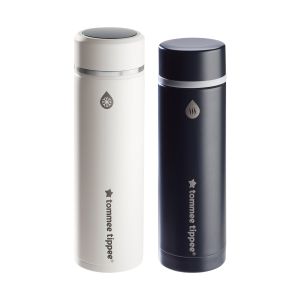
This is a demo store. No orders will be fulfilled.
Subscription orders can be cancelled at anytime. Free delivery on all subsequent subscription orders. Find out more about subscriptions.
They’re easy and fuss free
Your products are automatically sent to you
You save up to 10% when you sign up for a subscription
You can cancel at any time
As adults we all know how important it is to stay hydrated, but if you���ve just become a parent, you may be wondering when it'll be ok for your baby to have their first sips of water.
Let���s run through when babies can drink water, cover how much water they should drink as they grow and develop, and look into which kind of training cup is best.
No, before the age of six months, babies get all the hydration they need from breast milk or formula, even in hot weather, so there's no need for your baby to drink anything except breast milk or formula.
A baby's tummy is small, their brain is still developing, and their kidneys are immature, so giving them water to drink before their system is ready can lead to water intoxication ��� a serious health condition that occurs when the kidneys are given more water than they can handle.
If you're worried about water intoxication or concerned that your baby is dehydrated, you should seek medical attention right away.
Once they're six months old and you begin weaning, you can offer them a small amount of water at mealtimes (tap or filtered is fine). They won���t need a lot, but those few sips alongside a meal will get them used to the taste, and also help them learn to drink from a cup.
As you introduce solid foods, you'll find that your little one's appetite for breast milk or formula starts to reduce, and it's at this point that you can consider introducing water to keep them hydrated, especially as their activity levels increase.
Ideally, water should be the only alternative drink to breast milk or formula your baby has when weaning. Its natural pH is good for a baby's oral and dental health, and it's the most natural form of hydration.
If you choose to offer them fruit juice, make sure it's diluted one part juice to 10 parts water, and remember to avoid hot drinks like tea, and other fizzy or sweet drinks that contain artificial sweeteners and lots of sugar.
Once they turn 12 months old, you may still be breastfeeding, but you can start to introduce your baby to full fat or whole cow's milk, or even pasteurised goat's and sheep's milk if you're feeling adventurous!
Semi-skimmed milk (1-2% fat) can be introduced from two years of age, but skimmed milk (less than 0.5% fat) isn't recommended until children are five years old.
Unsweetened oat, almond and soy alternatives are also an option as part of a healthy, balanced diet, but they're not ideal as a main drink unless under certain circumstances or when a healthcare professional such as a dietitian has recommended them. It's also important to look at their labels and nutrition facts panels to see if they've been fortified with nutrients like vitamin D, calcium, and protein as these are really important for a baby's development.
It's important to note that babies and young children under five years old shouldn't be given rice drinks because of high levels of arsenic. Don't worry if your child has already had rice drinks, there's no immediate risk to them, but it's best to switch to a different kind of milk.
When thinking about how much water your little one should be drinking, it���s important to note that water can come from foods as well as drinks.
Drinks account for about 80% of fluid intake. While food accounts for another 20%. Fruits, vegetables, and milk are all good food sources of water, so a diet rich in these can contribute a higher amount of fluid to the overall intake. The table below refers to the total intake which includes both food and drinks.
| Age | Total Fluid Intake from Food & Drink Per Day (ml) | The Equivalent in Cups Per Day |
| 6 ��� 12 Months | 800ml ��� 1,000ml | Sips with meals |
| 1 ��� 2 Years | 1,100ml ��� 1,200ml | 3 ��� 4 Cups |
| 2 ��� 3 Years | 1,300ml | 4 ��� 5 Cups |
| 4 ��� 8 Years | 1,600ml | 5 ��� 6 Cups |
Every baby is different, and they will soon let you know what they do and don���t like. However, there are some general principles that can help when choosing bottles and cups as they grow.
For milk, a baby bottle with a breast-like teat is best. This helps your baby form a natural latch and makes transition from breast to bottle smoother if you're breastfeeding.
Once they're old enough to be introduced to water at around six months old, you can consider a cup with handles and either a soft spout or straw.
You'll probably want a non-spill valve, as learning to drink is pretty messy, and using a cup with a removable valve, your baby can practice free flow drinking, i.e. they don't have to suck. This uses different muscles and is good for their oral development.
Once they're around a year old, they're usually ready to move on from baby bottles altogether, and your little one may already know if they prefer a spout or straw, or you could try a sports top bottle so they feel a little more grown up!
Before long, they'll be happy drinking from an open cup.